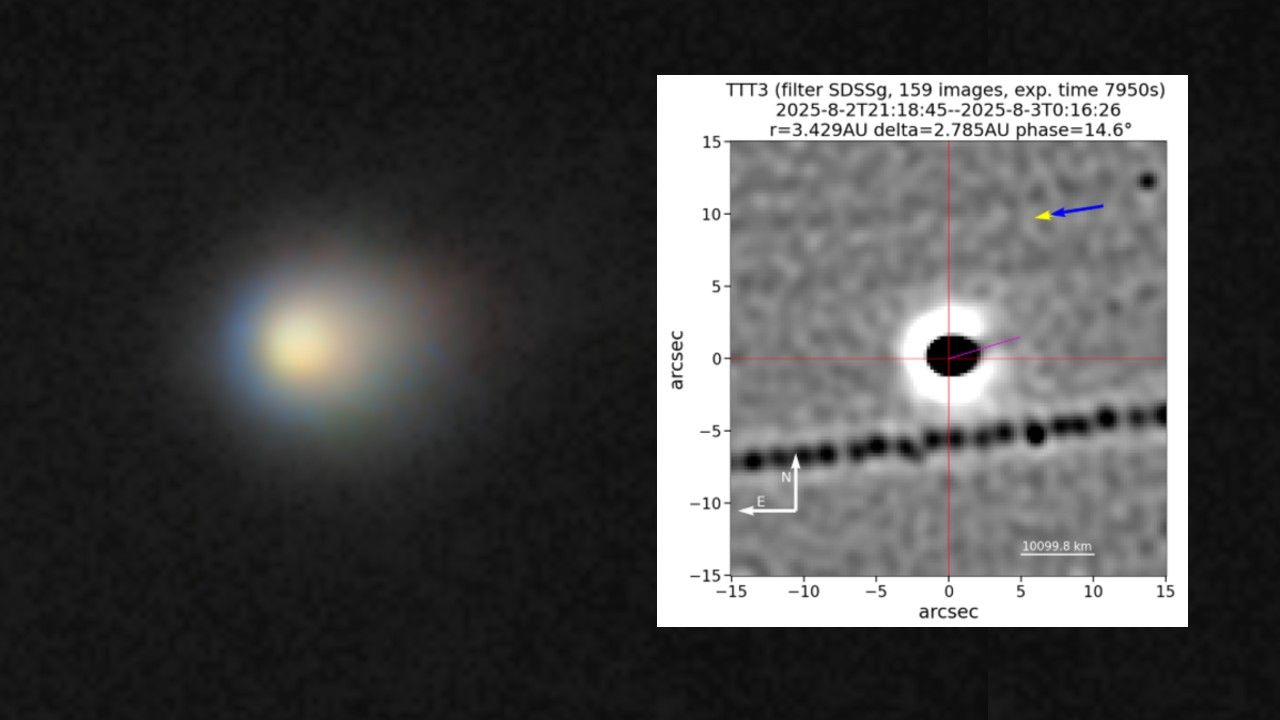Science
Interstellar Comet 3I/ATLAS Ejects Jet of Material Towards Sun

A new image reveals that the interstellar comet 3I/ATLAS is actively ejecting a jet of ice and dust towards the sun. This phenomenon occurs as the comet approaches our star, which is warming its surface. The composite image shows the comet’s nucleus as a black dot, surrounded by a white glow known as the coma, while the jet is indicated in purple, directing its material toward the sun.
3I/ATLAS is only the third interstellar object confirmed to have entered our solar system. It is on a trajectory that will bring it within 1.8 astronomical units of Earth on October 30, 2023, allowing for visibility with small telescopes before it moves away into the depths of space. This close approach presents a unique opportunity for astronomers to study its behavior.
On October 15, astronomers announced the presence of the jet in the Astronomer’s Telegram, a communication platform for the astronomy community. The notice was shared by Robert Rutledge, an associate professor at McGill University in Montreal. The jet was captured on August 2 using the Two-meter Twin Telescope at Teide Observatory in Tenerife, Canary Islands. The image results from combining 159 exposures of 50 seconds each.
According to Miquel Serra-Ricart, an astrophysicist and chief science officer at the Light Bridges research institution, the observed jet behavior is typical for comets. He noted that the comet’s tail also extends away from the sun, a characteristic feature of these icy bodies.
As comets draw closer to the sun, they experience uneven heating. Areas facing the sun warm rapidly, and if weaker spots on the comet’s surface exist, gases trapped beneath can sublimate and escape, creating the jets observed. Serra-Ricart estimated that the jet could extend as far as 6,200 miles (approximately 10,000 km) from the surface of 3I/ATLAS, a distance more than twice that of the widest part of the United States.
The composition of the jet is likely to include carbon dioxide and dust particles, mirroring findings from NASA’s James Webb Space Telescope in August. As the comet rotates, these jets can fan out, with some material remaining in the coma while other particles are pushed into the comet’s tail by solar wind pressure. This behavior was similarly observed in the C/2020 F3 NEOWISE comet, which was visible to the naked eye in 2020.
The ongoing observations of 3I/ATLAS provide important insights into the dynamics of interstellar comets as they interact with solar radiation and heat. As the comet continues its approach, it offers a valuable opportunity for astronomers to deepen their understanding of these fascinating celestial objects.
-

 Lifestyle3 months ago
Lifestyle3 months agoLibraries Challenge Rising E-Book Costs Amid Growing Demand
-

 Sports3 months ago
Sports3 months agoTyreek Hill Responds to Tua Tagovailoa’s Comments on Team Dynamics
-

 Sports3 months ago
Sports3 months agoLiverpool Secures Agreement to Sign Young Striker Will Wright
-

 Lifestyle3 months ago
Lifestyle3 months agoSave Your Split Tomatoes: Expert Tips for Gardeners
-

 Lifestyle3 months ago
Lifestyle3 months agoPrincess Beatrice’s Daughter Athena Joins Siblings at London Parade
-

 World3 months ago
World3 months agoWinter Storms Lash New South Wales with Snow, Flood Risks
-

 Science3 months ago
Science3 months agoTrump Administration Moves to Repeal Key Climate Regulation
-

 Business3 months ago
Business3 months agoSoFi Technologies Shares Slip 2% Following Insider Stock Sale
-

 Science2 months ago
Science2 months agoSan Francisco Hosts Unique Contest to Identify “Performative Males”
-

 Science3 months ago
Science3 months agoNew Tool Reveals Link Between Horse Coat Condition and Parasites
-

 Sports3 months ago
Sports3 months agoElon Musk Sculpture Travels From Utah to Yosemite National Park
-

 Science3 months ago
Science3 months agoNew Study Confirms Humans Transported Stonehenge Bluestones









